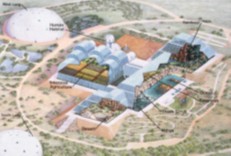|
 |
The Technology & Legal Compliance

 The use of wetlands to treat effluent is not a new idea. But in recent
decades, wetland scientists have deepened our understanding of how natural
wetlands function and provided the basis for the design of constructed
wetlands putting these systems to effective work to solve environmental
problems.
The use of wetlands to treat effluent is not a new idea. But in recent
decades, wetland scientists have deepened our understanding of how natural
wetlands function and provided the basis for the design of constructed
wetlands putting these systems to effective work to solve environmental
problems.
WASTEWATER GARDENS® (WWG) sewage treatment
system was initially developed in the Biosphere 2 Test Module in 1987,
and then put to full test in the world renowned first large scale global
ecology and closed systems laboratory experimental facility (1.2 hectares,
3 acre), BIOSPHERE 2, in Arizona, during its first years of closure experiments
from 1991 to 1994. The WWG system was designed in conjunction with NASA
scientists and managed and researched by Dr. Mark Nelson, a member of
the eight person Biosphere 2 crew in charge of the water cycle within
Biosphere 2. The wetland wastewater treatment system purified all sewage
water (from laboratories, workshops, human residences, laundry, animals
and agricultural operations.). The cycle of water being extremely accelerated
within Biosphere2 (4 days instead of 3-4 years on Earth), the water had
to be effectively treated and recycled in a healthy,  ecological manner in order for this mini biosphere and its inhabitants
to function well.
ecological manner in order for this mini biosphere and its inhabitants
to function well.
After leaving Biosphere 2, Dr. Mark Nelson, in collaboration with the
Planetary Coral Reef Foundation (PCRF) and the Institute of Ecotechnics,
working with the eminent systems ecologist, H.T. Odum of the Center for
Wetlands at the University of Florida, further refined the WWG design
to make it adaptable and available for application worldwide, in a wide
diversity of ecosystems.In the decade following Biosphere 2, WWG systems
have been installed in Algeria, Australia, Belize, Europe (France, Poland,
Portugal, Spain), Indonesia, Mexico, the US and The Bahamas.
Legal Requirements
Subsurface flow constructed wetlands have been reviewed by the U.S.
Environmental Protection Agency (EPA), Australian authorities, European
Health authorities and various other countries' agencies, and meet their
wastewater standards.
All constructed wetlands designed and built by WWG team around the world
have met and often exceeded requirements of purification provided they
were well maintained as trained and indicated on the Maintenance Manual.While
the ability of WWG systems for water decontamination is often above
local Health Authority treatment requirements, when even higher treatment
than normal municipal standards is required for special purposes (areas
classified as sensitive ecological zones for example), the area of the
wetland is increased and/or made of both horizontal and vertical flow
wetlands, thus providing the equivalent of advanced water treatment.
Today, this ecotechnology is finally being proven to be far more effective,
affordable and long-lasting than conventional sewage treatment system
(high energy consumption, mechanical brake-downs, expensive maintenance),
although they are not always adaptable to all situations (higher requirement
of land than most conventional sytems). However, regulatory guidelines
and trainings differing markedly from country to country, it can be
necessary to educate health department officials to sewage treatment
via constructed wetlands before the permission to implement a WWG system
be granted.
|

 The use of wetlands to treat effluent is not a new idea. But in recent
decades, wetland scientists have deepened our understanding of how natural
wetlands function and provided the basis for the design of constructed
wetlands putting these systems to effective work to solve environmental
problems.
The use of wetlands to treat effluent is not a new idea. But in recent
decades, wetland scientists have deepened our understanding of how natural
wetlands function and provided the basis for the design of constructed
wetlands putting these systems to effective work to solve environmental
problems. ecological manner in order for this mini biosphere and its inhabitants
to function well.
ecological manner in order for this mini biosphere and its inhabitants
to function well.




